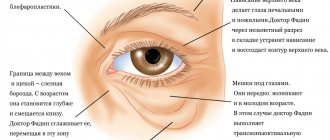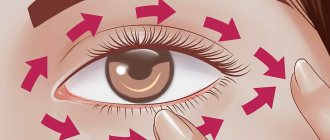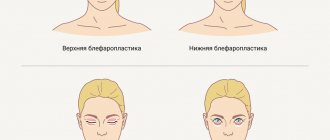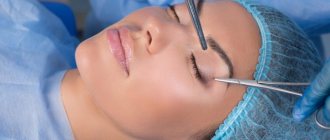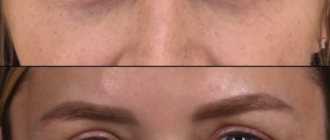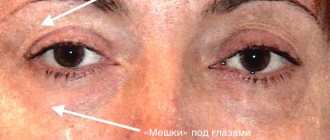What is eyelid blepharoplasty and in what cases is it indicated?
Blepharoplasty is one of the simplest and most popular operations in plastic surgery. This helps combat sagging skin folds on the upper eyelid and bags under the eyes. In addition, with the help of blepharoplasty, you can change the shape and shape of the eyes. As a person ages, the skin of the eyelids loses its elasticity and gradually sag, which contributes to the appearance of deep wrinkles. Fatty formations can also accumulate in it, which leads to excess skin.
Plastic surgery has been helping people deal with the problem of age-related changes in the eyelids for many years, using various methods, such as:
- Blepharoplasty of eyelids (upper or lower);
- Transconjunctival blepharoplasty of the lower eyelids;
- Circular (or combined) eyelid surgery (lower and upper).
As many years of medical practice have shown, the skin of the eyelids heals quite quickly. Thanks to this, already six months after the operation, the stitches become completely invisible; they literally merge with the epidermis. In clinics, surgeons evaluate the final results of such operations within one and a half to two months. By this time, the swelling has completely passed and a scar has formed. As a rule, the postoperative result lasts a long time (from seven to ten years), but the duration of the effect can be affected by the patient’s lifestyle.
There are a number of indications for eyelid blepharoplasty. It can be:
- Deep folds in the corners of the eyes;
- Wrinkles in the lower eyelids;
- Excess skin (or overhang);
- Excessive fat deposits on the eyelids;
- Swelling in the upper eyelids, giving a tired look.
Patients often come to the clinic for consultation with a plastic surgeon about a possible change in the shape or shape of the eyes. In such cases, doctors offer blepharoplasty, but only if there are no contraindications. Eyelid surgery is also used to eliminate any aesthetic defects (for example, these may be hereditary changes).
Eyelid surgery - blepharoplasty
Eyelid surgery or blepharoplasty is one of the most popular operations in the arsenal of plastic surgeons to improve the appearance of the eyelids, which can easily eliminate drooping lower corners of the eyes, bags under the eyes, wrinkles, and drooping upper eyelids. The small amount of intervention and the excellent anti-aging effect attract not only women, but also men. Blepharoplasty is performed frequently and with good results. Indications for eyelid surgery:
- "aging" eyelid
- tired look (“heavy” eyelids)
- sagging skin of the upper eyelid
- "bags" under the eyes
- excess skin of the lower eyelids
The following main types of blepharoplasty are distinguished:
Upper blepharoplasty - eliminates excess skin of the upper eyelids. This type of operation is performed through a skin incision located along the crease of the upper eyelid. This incision is used to remove excess skin. Most often, in conjunction with this operation, plastic surgery of the muscles of the upper eyelid and removal of excess fatty tissue are performed, although it happens when it is enough to remove only “excess” skin.
Lower blepharoplasty - helps to get rid of excess skin under the eyes, swelling and hernias.
The suture from the operation runs along the ciliary edge of the lower eyelid (transcutal or subciliary blepharoplasty). Also, on the lower eyelid, transconjunctival blepharoplasty can be performed, when the incision is on the inside of the eyelid. This type of operation is possible if only redistribution or removal of fatty tissue around the eyes is required, without removing skin flaps. This type of blepharoplasty is relevant for young patients. Circular blepharoplasty is simultaneous plastic surgery of the upper and lower eyelids.
It is also possible to combine blepharoplasty with a facelift or just a forehead lift.
However, it is better to carry out these operations sequentially - first a facelift, and then eyelid surgery. Blepharoplasty cannot “remove” wrinkles in the corners of the eyes (“crow’s feet”). “Double bags” under the eyes are difficult to correct and are often caused by anatomical features, as well as muscle weakening and lymphostasis. Preparation for surgery Preparation
for surgery begins with an initial consultation, at which the patient’s wishes and surgical options for correcting the changes that have occurred are discussed. A plastic surgeon, having thoroughly assessed your anatomy, will determine the reasons for changes in the eyelid area and choose a method for their correction. Before blepharoplasty, you will need to undergo a medical examination to identify possible contraindications. Conjunctivitis, blepharitis, dry eye syndrome and glaucoma will require preoperative treatment. Absolute contraindications are chronic eye diseases, any acute diseases and severe myopia (myopia). 2 weeks before surgery, stop taking medications that increase tissue bleeding (aspirin, heparin, Trental, etc.). During this period, quitting smoking and alcohol and taking hormonal medications is indicated. On the eve of the operation and immediately before it, tranquilizers and drugs that relieve tension in the nervous system are prescribed. The day before the operation, you are allowed to eat only liquid food, and on the day of the operation you must completely stop eating.
As soon as the patient is at the clinic, nurses escort him to the ward.
Photography is in progress. For this operation, the standard is photography in 5 standard projections: full face, profile on both sides and half-turn on both sides. After this, the surgeon makes markings. Preoperative marking is an important stage of the operation; if performed correctly, it is a guarantee of obtaining the desired result. After the surgeon has made the markings, it is strictly forbidden to rub your face and eyes with your hands, a towel, napkins, etc., as this may spoil the markings. The operation
Blepharoplasty of the upper and lower eyelids is performed in a hospital setting, both under anesthesia, in combination with local anesthesia, and only under local anesthesia. In most cases, these operations are performed simultaneously. Eyelid surgery is performed in the supine position. On the lower eyelids, surgery can be performed using a closed (transconjunctival blepharoplasty) or open method. With the closed method, the lower eyelid is retracted, the ligament is separated and a small incision is made from the inside through which excess fatty tissue is removed. After the operation, the ligament grows back to the orbicularis oculi muscle, a dense scar frame is formed, which strengthens the ligament 5.5 times. In what cases is the closed method used in lower eyelid surgery?
There is a certain test by which the surgeon determines which method to use.
But most often, transconjunctival blepharoplasty is performed on patients who have large bags, but no deep wrinkles. The open method involves excision of a strip of overstretched muscle and skin. In this case, the incision, which is practically invisible, is made under the eyelashes. On the upper eyelids, the operation is performed exclusively in an open manner, and the incision is made in the fold of the upper eyelid. The operation ends by closing the suture area with a special thin sterile surgical sticker. This protects the delicate seam from external influences. Once the operation is completed, the patient is transferred to his room. The patient is observed for some time and then discharged home. Go home - preferably accompanied by one of your friends or relatives. Result after surgery
You will be satisfied with your new appearance after you have recovered from the surgery. In general, blepharoplasty is characterized by a short recovery period and minimal risk of complications. However, the first weeks of the recovery period after eyelid surgery can significantly affect the outcome of the operation, so it is imperative to write down and strictly follow all the surgeon’s recommendations without exception. Sutures are removed 4-7 days after surgery (individually), by this time postoperative bruises and swelling have gone away. Before the stitches are removed, under no circumstances should you touch, rub or otherwise influence the skin around the eyes. You will have to refrain from using contact lenses and cosmetics. In addition, for several days after blepharoplasty, the eyes will need absolute rest - it is necessary to exclude reading, TV and computers, and also, if possible, avoid exposure to bright light, it is advisable to wear sunglasses for another 2-3 weeks. Drinking alcohol and smoking are also prohibited. You should also refrain from very salty foods - this also increases swelling. After about 7-10 days, you will be able to return to your normal lifestyle, with the exception of intense physical activity, which is possible no earlier than 3 weeks after eyelid surgery. In its final form, the result of the operation can be assessed after 1-1.5 months, and the achieved effect lasts for at least 5 (usually 7-10, in some cases up to 15) years.
View price
How is blepharoplasty of the upper and lower eyelids done?
As a rule, blepharoplasty is performed quickly and painlessly. The postoperative period does not last long - in standard cases, the patient can go home on the day the operation was performed. He is being monitored on an outpatient basis.
When performing surgery in the area of the upper eyelids, the surgeon makes the necessary incisions in the places where natural folds form. Therefore, after such a surgical intervention, the scar remains invisible with open eyes. If the task is to remove excess skin, the doctor excises a spindle-shaped flap of skin. During surgery, depending on the wishes of the patient, the specialist can tighten the orbicularis oculi muscles, remove a fatty hernia, or change the location of the lacrimal gland.
Blepharoplasty on the lower eyelids is performed under the natural lash line. The doctor makes thin incisions, separating fatty tissue, muscle and skin. During lower eyelid surgery, fat deposits are removed and weakened skin is corrected. At the end of the surgical intervention, the specialist applies cosmetic sutures in the places where the incisions were made.
A separate method of eyelid correction is transconjunctival blepharoplasty, which is used in exceptional cases when the patient needs to remove excess fat deposits in the lower parts of the eyelid. This operation is most often indicated for young people. In the case of transconjunctival blepharoplasty, the surgeon makes a small puncture or a very small incision in the inner part of the lower eyelid and removes excess fat accumulations through the resulting hole. After such an intervention, there are practically no traces left, since the operation itself involves minimal manipulation on the outer (visible) side of the eyelid. The procedure will not affect a person’s facial expressions during the rehabilitation period, the scars will be invisible, and the recovery process itself will not last long. However, the operation does not involve any significant changes in the shape or shape of the eyes.
In the field of plastic surgery, there is such a thing as laser blepharoplasty.
In this type of operation, the usual surgical scalpel is replaced by a laser. This type of blepharoplasty has its advantages over other types of eyelid surgery, which is why it has become very popular in recent years. So, among its advantages are:
- No scars. The procedure is practically bloodless. The laser leaves no marks and guarantees rapid healing.
- Operational implementation. It is carried out very quickly - usually the doctor copes with the task in half an hour.
- Expected Result. A plastic surgeon, using the laser correction method, better controls the process and monitors the progress of the operation.
- Fast recovery period. After laser blepharoplasty, swelling is less than when using a scalpel. Accordingly, the period of postoperative rehabilitation is significantly reduced.
Functional and cosmetic blepharoplasty - what's the difference?
Cosmetic eyelid blepharoplasty refers to surgery that is not medically necessary. This procedure occurs at the initiative of the patient who wants to change his appearance. Most often, the cosmetic type of eyelid correction is chosen by people aged 45 years and above, when signs of age begin to appear - baggy, sagging eyelids and others. As a person gets older, the skin in this area of the face tends to stretch and the muscles weaken. As a result, fat bags begin to form. Sometimes this problem can occur at a younger age. Such manifestations are often hereditary.
Unlike cosmetic, functional blepharoplasty is an operation that is performed for medical reasons. Functional eyelid lift is performed in most cases to remove baggy skin that sag, interferes with good vision and prevents a person from leading a normal life. Sometimes this can interfere with the process of wearing glasses and contact lenses. In such cases, surgery is also recommended by doctors. Other indications for this operation are discomfort in the forehead due to congestion of the muscles involved in the process of lifting sagging eyelid skin, as well as irritation caused by friction of the folds.
Blepharoplasty: before and after
Before prescribing the operation, the attending physician will necessarily interview the patient, examine him and give certain recommendations. After this, the specialist will prescribe a series of tests, based on the results of which he will be able to judge the absence of contraindications to this surgical intervention. If blepharoplasty does not pose a risk to a person's health, the doctor will discuss with him what anesthesia he will use - local or general anesthesia. In the first case, the patient is conscious throughout the entire operation, but does not feel discomfort, since a special drug is previously injected into the operated area, which causes numbness. General anesthesia is recommended for more complex blepharoplasty. The duration of such an operation largely depends on whether both eyelids will be affected or only one. If the surgeon is faced with a task of increased complexity, surgery can last up to two hours.
In this case, the day before the planned procedure, the patient should follow the following instructions:
- Stop taking blood thinners to promote normal clotting during surgery. This point also applies to painkillers, which it is advisable to exclude two weeks before the planned procedure;
- On the eve of the operation, do not eat heavy food;
- Avoid excessive drinking and do not eat after midnight;
- Do not apply cosmetics to your face on the day of surgery.
As a rule, the patient can leave the clinic soon after the operation without staying overnight, unless general anesthesia was used. During the postoperative period, it is important for a person not to neglect the doctor’s recommendations. For a short time, you may have to partially change your lifestyle. After surgery, as a rule, an antibacterial ointment is indicated, which is applied to the skin of the eyelids. On the first and second days after blepharoplasty, cold compresses are often recommended to relieve swelling and bruising, and on the third day, warm compresses are recommended, which promotes rapid healing.
During the initial stages of the recovery period, discomfort in the eye area is possible - this is a common but short-lived side effect. After a few days, the discomfort will pass, but complete healing will occur in about two weeks. Until this moment, it is highly undesirable to use any eye cosmetics. In the first days after surgery, you should refrain from using contact lenses until the swelling decreases. If the doctor used regular sutures rather than absorbable ones, a week after blepharoplasty they will need to be removed in the clinic where the operation was performed.
Blepharoplasty is an ordinary procedure in plastic surgery, but sometimes complications arise after it is performed. For example, the patient may complain of an inability to close the eyelids completely. This condition sometimes lasts up to several months. It is dangerous because it causes dry eyes. Usually, for this type of complaint, eye drops are prescribed, and in rare cases, special pads that are used during sleep. Other side effects are also possible, such as incorrect placement of the eyelids, the formation of noticeable scars, etc. But in most cases, blepharoplasty brings positive results and is easily tolerated.
On the website Ochkov.Net you can get acquainted with a wide range of contact correction products from world brands!
Recovery, limitations and possible complications
This is an operation with a short recovery period. Immediately after the procedure, slight swelling and bruising may be observed.
First 3 days
Immediately after surgery, cold is applied to the eyelids, this helps reduce bruising and swelling. During this period, you should minimize any movements and try to rest as much as possible. I recommend doing cold tea lotions at home for 3 days. After 5 days, remove the stitches.
Subsequent period
Hematomas and swelling disappear within 7-10 days if all the surgeon’s instructions are followed and the regimen is followed. You can undergo physiotherapeutic procedures that will speed up the recovery process.
Restrictions
After blepharoplasty, you should not watch TV or sit at the computer for a long time for 2-4 days, or read books. You can wear contact lenses after a couple of weeks, and with transconjunctival plastic surgery no earlier than a month. It is better to quit smoking and drinking alcohol for the entire recovery period.
When can I return to work?
Returning to work is possible no earlier than 4-5 days later, unless the work involves intense physical exertion or prolonged exposure to a monitor.
Possible complications
Complications of blepharoplasty are extremely rare, but you should still be aware of what surprises may arise:
- bleeding,
- seam divergence,
- itching and rash,
- bruises,
- infectious complications,
- impaired secretion of tear fluid,
- inversion of the lower eyelid,
- formation of noticeable scars,
- drooping eyelid (especially in elderly patients).
If you follow all the doctor’s recommendations, the risk of any of these complications is almost zero.

